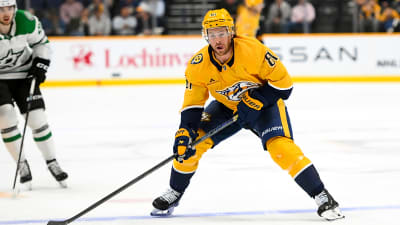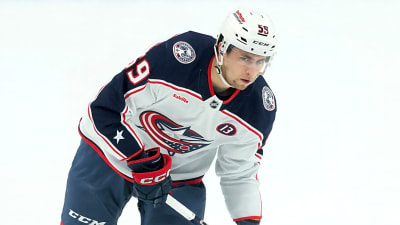It’s that time of the year for The Win Column’s NHL Draft Rankings and Draft Profiles! Earlier this week, we released the TWC consolidated 2025 NHL Draft rankings. The 2025 NHL Draft will take place on June 27 and 28 in Los Angeles. In this iteration, we are looking at a draft profile for Slovakian-born SHL forward Michal Svrcek.
Who is Michal Svrcek?
| Player | Position | Handedness | Height | Weight |
|---|---|---|---|---|
| Michal Svrcek | C/LW | Left | 5’10” | 176 lbs |
The Slovakian-born forward is a product of the Zilina youth academy, playing at their U16, U18, and U20 levels before finding a clearer developmental path in Sweden. Svrcek moved to Gävle, Sweden, for the 2022–23 season, where he has since appeared for the Brynäs IF organization for their J16, J18, J20, and SHL teams.
Svrcek has also appeared for Slovakia internationally at U16, U17, U18, and even U20 teams, often playing a year or two up.
Most recently, the Slovakian has split this past 2024–25 season between the J20 Brynäs IF and their SHL counterpart. With their J20 squad, he served as a power play specialist with good pace, timing, and positioning. At the SHL level, Svrcek was a depth scoring, energy, and pace-moving bottom-six forward.
Svrcek’s on-ice production
| Year | Draft Relative | League | Team | GP | G | A | P |
|---|---|---|---|---|---|---|---|
| 2023–24 | D-1 | J18 Region | Brynäs IF | 15 | 11 | 9 | 20 |
| J18 Nationelll | Brynäs IF | 4 | 2 | 3 | 5 | ||
| J20 Nationell | Brynäs IF | 22 | 5 | 7 | 12 | ||
| WJC-18 | Slovakia | 7 | 0 | 1 | 1 | ||
| International Jr. | Slovakia | 14 | 10 | 9 | 19 | ||
| 2024-–25 | D+0 | J20 Nationell | Brynäs IF | 30 | 14 | 16 | 30 |
| SHL | Brynäs IF | 17 | 1 | 2 | 3 | ||
| WJC-18 | Slovakia | 7 | 2 | 2 | 4 | ||
| U18 | Slovakia | 6 | 4 | 4 | 8 | ||
| U20 | Slovakia | 4 | 0 | 0 | 0 |
Svrcek’s time on ice ranged greatly depending on the level, but averaged 13:57 across all levels. The 5’10” forward makes impacts in all three zones and plays with a high motor that indicates hints of a two-way forward.
His game is highlighted by a relentless compete level, quality skating, and offensive awareness.
Svrcek’s strengths
Skating
Skating is the basis of Svrcek’s game, due to quality skating mechanics, posture, flexion, stride, extension, and agility, all of which are notable assets to his skating toolkit. Additionally, his top speed, quickness, and decent stride recovery regularly make him an asset on retrievals and reloads.
This effectiveness on retrievals is further complemented by the establishment of quality body positioning on opponents as soon as the Slovakian enters the offensive zone, and quality route creation that often creates space and generates high danger chances for the young forward.
This skating aptitude makes the forward a larger asset in both offensive and defensive transition, as he rarely is sitting still and shows decent positioning, regularly shows high-end pace, and acceleration elements that routinely make the 5’10” Slovakian a rush asset at both the SHL and J20 levels.
Svrcek’s skating meshes well with his two-way game, as it influences his agility, acceleration, and pace, generating quality angles of attack and the ability to close gaps quickly. This combination makes Svrcek a consistent pressure generator on both the forecheck and in offensive zone entries.
Compete level
Svrcek’s skating also blends seamlessly with his compete level. His compete level is highlighted by his relentless pace/motor, high-quality hustle, and high-frequency play engagement in all three zones. He rarely has a shift that he does not try to involve himself in some manner.
This effort level shows flashes of above-average spatial awareness and lane manipulation. All of these factors combine to make the 5’10” forward a high-energy and slightly dynamic, always in movement threat for his opponents.
This compete level is best articulated in defensive transition, where Svrcek plays an active role on the forecheck and the back-check. This activeness displays quality play engagement that blends seamlessly with an active stick and play disruption elements.
While Svrcek himself plays with pace, he knows very well how to slow the pace of play down for opponents. He is regularly a turnover generator with clean defensive pressure, relentlessness, and quality skating; he often follows through. Overall, the Slovakian generates 2.7 takeaways per game.
In offensive transition, this compete is shown through good outside-inside lane changes, consistent hustle, positional responsibility, and a consistent motor throughout all of his shifts in a game.
In the offensive zone, this compete portrays itself through his active role as a net-front presence, where he distracts defenders, is constantly shifty, and shows high-end intensity.
Svrcek does not control the pace of play in the offensive zone, but he does show good play support elements, which hint at compete and awareness.
Awareness
The Brynäs IF product has shown significant growth in play-reading and contributions over this past season, and a large part of that is due to his awareness on the ice. From his high scan frequency, he establishes good space awareness, offensive awareness, and rush instincts.
This defensive awareness explains his activeness on the back-check and is best articulated by his extremely low 0.01 errors leading to goals per game. He abuses the gaps opponents create as the high forward in-zone and quickly closes them while displaying solid lane awareness and stick positioning.
He remains quite positionally responsible and shows some capable play anticipation both off and on the puck.
Offensively, he displays a high level of rush instincts, which might be a large area of growth for him next season, as he improves his timing and finishing ability. Even this past season, he still showed he could generate chances—often by himself—to the tune of 1.97 per game, with a 12% conversion rate.
He often knows where he needs to be on the ice, too, and at the J20 level, he was Brynäs IF’s power play specialist, with a majority of his 30 points coming on the man advantage. This might explain his 0.25 expected goals for. It also shows the Zilina product could benefit from more offensive poise.
Further complementing his awareness are flashes of puck handling and puck protection elements.
Svrcek’s areas of improvement
Physicality
Physicality is one of the largest barriers for Svrcek as the player is still getting used to playing with tougher opponents. The most evident issues are around his frame, muscle mass, and physical pressure absorption.
These physical shortcoming makes everything from offensive play executions to risk mitigation more difficult for the 2007-born forward.
Simply put, he loses puck battles—16 per game, yet a 44% winning percentage—position battles, and board battles on the regular, and this is where natural growth in the weight room and more experience could be beneficial for the young forward.
Additionally, where he shows willingness to engage in plays, this is often hampered by both his hit frequency, effectiveness, and efficiency. Although he only records 0.45 hits per game, if that number included ineffective hits, it would be significantly higher. This tendency can lead to him chasing plays.
He also raises questions in terms of grit, effective angling, and body leverage in his defensive zone play. This results in only 0.43 shot blocks per game, which explains his average of only 15 seconds on the penalty kill. This also reduces his projection at the NHL level if he is not a penalty killer.
Some issues around endurance are evident later on in games.
This toughness is not unusual for younger, smaller forwards, and this is something that can be worked out—literally and figuratively—as the player ages and develops further. To play at the NHL level, he will need to unlock more physical power in his game, which will benefit both his skating and shooting as well.
Puck skills
As mentioned earlier, Svrcek has some good flashes of puck handling. However, his larger puck management shows some areas of concern.
The 5’10” Slovakian shows puck management lacks due to poor pass selection, issues around decision making, and overarching play-making shortcomings. These elements are all intertwined and show some limitations around developing dynamic offensive instincts, hockey IQ, and option identification.
One of the best examples of these shortcomings is his tendency to force plays by either taking on three opponents alone, implementing ineffective defender-manipulation, sending questionable passes, or issues arising around facilitating plays that aren’t straightforward.
His five giveaways per game and pass accuracy of 85% are a statistical testament to some of these shortcomings.
Svrcek’s shooting itself is around average, with okay mechanics, release point, leg kick, balance, and power. He averaged 3.8 shots per game, but only found the net with 63% of them. Accuracy could be improved, and shot selection does border on questionable at points.
One of the most frustrating things about the prospective second-rounder is that there are moments where he shows elite-level offensive playmaking that are amplified by his skating and compete. This inconsistency itself is another hurdle that Svrcek will have to overcome if he ever makes the NHL.
Svrcek’s comparables
NHL Comparable: Artturi Lehkonen. A forward who uses his compete level and some above-average skating to generate chances and find the net.
NHL ETA: 5+ years
Fit with the Flames
The Calgary Flames have rarely looked to Sweden in recent drafts, as the club has selected only four players since the 2018 draft—four out of 45 picks. Svrcek has the skating, compete, and awareness of other recent Flames draftees.
It’s just a matter of whether Calgary wants more purely soft-skill players in their pipeline or not. He’s also a lot more of a long-term project than some of the other forwards in the Flames pipeline, with an NHL ETA of four to five years or more.
Summary
He has elements that organizations will like in terms of skating, compete, and awareness/positioning. This being said, there are elements of his game that cause frustration in his overall ineffectiveness. While not insurmountable, they do limit his overall potential at the NHL level.
While Svrcek does not possess a certified dynamic skillset, he could carve out a depth scoring role at the NHL level if everything goes right due to his skating and compete alone.
Risk: 4/5
There’s moderate risk, largely because Svrcek doesn’t show any dynamic skill in a particular area, while also showing limited pro-transferability in the skillset that he does have. This limited on-ice identity, combined with significant physical and playmaking barriers, makes him a risky pick.
He is a prime candidate to fall to the middle rounds of the draft.
Reward: 2/5
If his name is called in the second round, he will be more of a project pick. Svrcek is signed to an SHL deal for the next two years, and it’s also possible that he spends more than those two years developing in Europe. If he does find a role in the NHL, it’s likely as a bottom-six scoring forward.
This isn’t an ideal role for a possible second-round pick.
Projection: Bottom-six scoring forward
Check out all of The Win Column’s individual player profiles of selected 2025 NHL Draft prospects:
Matthew Schaefer | Michael Misa | James Hagens | Porter Martone | Anton Frondell | Victor Eklund | Roger McQueen | Caleb Desnoyers | Jackson Smith | Jake O’Brien | Carter Bear | Radim Mrtka | Lynden Lakovic | Brady Martin | Justin Carbonneau | Malcolm Spence | Cameron Reid | Logan Hensler |Cameron Schmidt | Ben Kindel | Kashawn Aitcheson | Cullen Potter | Braeden Cootes | Ivan Ryabkin | Blake Fiddler | Cole Reschny | Joshua Ravensbergen | Bill Zonnon | William Moore | Jack Nesbitt | Jack Murtagh | Milton Gastrin | Sascha Boumedienne | Henry Brzustewicz | Adam Benak | Shane Vansaghi | Cole McKinney | Jakob Ihs-Wozniak | Ryker Lee | Ben Kevan
More must-reads:
- Ducks sign starting goaltender to a new five-year deal
- Insider shares major LeBron James retirement update
- The 'MLB All-Star Game MVPs' quiz
Breaking News
Trending News
Customize Your Newsletter
 +
+
Get the latest news and rumors, customized to your favorite sports and teams. Emailed daily. Always free!








